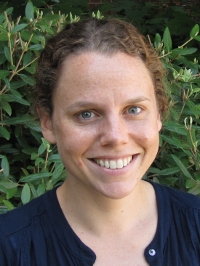Past NIMBioS Postdoctoral Fellow
Caroline Farrior
 Dates: September 2014 – July 2016
Dates: September 2014 – July 2016
Personal website
Twitter: @carolinefarrior
Project Title: Rare disturbance events and their impact on evolutionarily stable strategies of forest trees in competition for light, water, and nutrients
Caroline Farrior (Ecology and Evolutionary Biology, Princeton, 2012) examined the roles of frequency, severity and predictability of wind storms and drought in determining properties of forest stands. After completing her fellowship, Farrior accepted a position as as an Assistant Professor in the Department of Integrative Biology at the University of Texas at Austin.
LiveScience Profile Q&A with Dr. Farrior: How plants affect the global carbon cycle
NIMBioS Seminar: Plant traits and the importance of competition among individuals
![]()
Video Interviews
Feature Story: Dominance of the suppressed: Power-law size structure in tropical forests
Publications while at NIMBioS
- Farrior CE. 2019. Theory predicts plants grow roots to compete with only their closest neighbours. 286. Proc. R. Soc. B. [Online]
- Farrior CE, Bohlman SA, Hubbell S, Pacala SW. 2016. Dominance of the suppressed: Power-law size structure in tropical forests. Science, 351(6269): 155-157. [Online]
- Farrior CE, Rodriguez-Iturbe I, Dybzinski R, Levin SA, Pacala SW. 2015. Decreased water limitation under elevated CO2 amplifies potential for forest carbon sinks. PNAS. [Online]
Data/Software while at NIMBioS
- Farrior CE, Rodriguez-Iturbe I, Dybzinski R, Levin SA, Pacala SW. 2015. Data: Decreased water limitation under elevated CO2 amplifies potential for forest carbon sinks. [Online]
Media Coverage
- In rainforests, battle for sunlight shapes forest structure. Science Codex (7 January 2016)
- In rainforests, battle for sunlight shapes forest structure. Princeton Journal Watch (8 January 2016)
- Study reveals deep ties between diverse tropical rainforests. NSF Science 360 (11 January 2016)
NIMBioS
1122 Volunteer Blvd., Suite 106
University of Tennessee
Knoxville,
TN 37996-3410
PH: (865) 974-9334
FAX: (865) 974-9461
Contact NIMBioS


